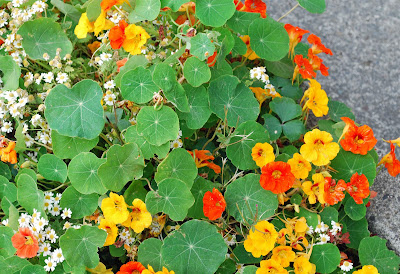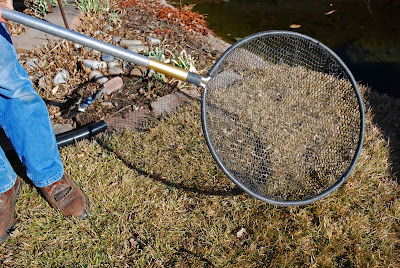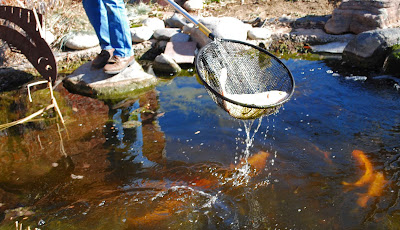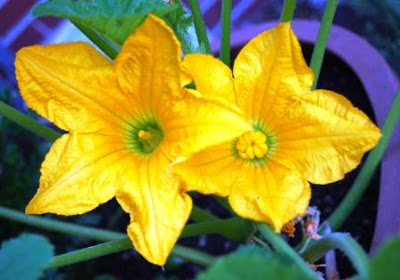 It's time. Kyoto has been in quarantine now for over two weeks. Despite daily dosage with a "prescribed" medication, he has not shown much improvement.
It's time. Kyoto has been in quarantine now for over two weeks. Despite daily dosage with a "prescribed" medication, he has not shown much improvement. In fact, he has gone into deeper stress,
In fact, he has gone into deeper stress, as evidenced by the reddening along his sides here, just behind the gills:
as evidenced by the reddening along his sides here, just behind the gills: So it's back to the pond for Kyoto, to be with his pals. Good luck, Kyoto!
So it's back to the pond for Kyoto, to be with his pals. Good luck, Kyoto!
PS As of this morning, Kyoto has been back in the pond for three days and is not showing any sighs of deteriorating health; he's hangin' in there!
Friday Afternoon Garden Club

It’s FAC time in The Art Garden! Grab your favorite beverage and pull up a chair. You didn’t really want to work this afternoon anyway, did you? Leave a comment to join the garden party.
Today’s topic:
Do you have zone envy? If you could grow plants from any climate/region of the world, where would it be? Why?
PS I'm updating the look of my blog with a wider text box and a new, subdued color palette. What do you think? I'd appreciate your feedback. Thanks!
Garden Designers Roundtable: Fantastic Foliage Factoids
Today I’m participating in the monthly Garden Designers Roundtable. Join us as we share our ideas about foliage---what it is and how to use it in the landscape.
Foliage is really the heart of the garden. It cloaks our plants with the colors and textures that create the lush, complex and rich aesthetic experience that we all crave. As a landscape designer I must often rely on my visual memory and employ a descriptive vocabulary to communicate about plants with my clients. Botanists use very specific terminology to identify and classify plants, and leaves have their very own world of weird and wonderful words. Amaze your friends! Astound your children! Impress your mother-in-law! Grow your foliage vocabulary and Trivia Night will never be the same. Here are just a few examples…
First, let’s look at the way leaves are composed.
A simple leaf consists of a single segment, like this Salvia sp., culinary sage:
A compound leaf consists of two or more segments called leaflets. There are at least eight types of compound leaves, but here are two examples that are fairly common. The composition of this Sorbus acuparia, European mountain ash, is oddly-pinnately compound. The leaflets are arranged along a rachis (axis), with a leaflet also present at the tip (terminal).

The Aesculus glabra, Ohio buckeye, has leaves that are palmately compound. There is no rachis present; instead, the leaflets radiate from the apex (upper end) of the petiole (leaf stalk).

Don’t be fooled. The simple leaf of this Acer palmatum, Japanese maple, is cleft (deeply indented, about half way to the mid vein), creating a 5-fingered palmate shape (A hint, there in the Latin name!).

This Chamaebatiara mellefolium, fernbush, leaf is also a trickster. It looks compound, but is just divided (indented all the way to the mid vein).

Round leaf shapes, like these, are orbicular. Nelumbo nucifera, sacred lotus:

Tropaeolum majus, nasturtium:

This Ipomoea purpurea, morning glory has a classic cordate, or heart, shape:

And how about the oblanceolate shape of this kale leaf? And, say, what’s up with the surface there? It’s papillate, covered with pimple-like bumps (Eeeeew!).
Brassica oleracea, Tuscan or - much more funner! - dinosaur kale:

Glossy leaf surfaces, illustrated by this ‘Cleveland Select’ ornamental pear, Pyrus calleryana, are glabrous:

Dull surfaces are, well, dull. No photo needed.
The beautiful, bluish-white waxy coating on this cabbage foliage is called glaucous. By the way, did you know that kales that do not form heads are termed acephala (headless)? What twelve-year-old would not want that word in their arsenal of insults?!

Many, many leaf surfaces have hairs of some sort. Long, short, fine, coarse, wooly, or velvety and they all have weird and wacky names, of course. Here's a photo of one of my plants with its canescent (dense mat of grayish-white [but not curled and interwoven!]) hairs. Behold, Verbascum bombyciferum, giant gray mullein:

Other visual (and named!) foliage characteristics, in addition to composition, shape, and surface, that may be use to describe and/or identify plants, include leaf arrangements, margins, venation, apices, and bases. I’ll save those for another time…
Today, as you visit the posts of my fellow Roundtable bloggers (see links below) or stroll through your own garden, see how many “garden geek” words you can use to describe the foliage that you see. You may even wow yourself!
Resources:
Manual of Herbaceous Ornamental Plants, Steven M. Still
Manual of Woody Landscape Plants, Michael A. Dirr
Vascular Plant Families, James Payne Smith, Jr.
Links to participating Garden Designers Roundtable members:
Christina Salwitz,
Debbie Roberts, Garden of Possibilities
Rebecca Sweet, Gossip in the Garden
Friday Afternoon Garden Club
It’s FAC time in The Art Garden! Grab your favorite beverage and pull up a chair. You didn’t really want to work this afternoon anyway, did you? Leave a comment to join the garden party.
Today’s topic:
When you travel do you make it a point to visit public gardens, botanical gardens, arboretums or garden centers/nurseries? What/where are some of your favorites?
Wordless Wednesday
Fox Scat
 Base of birdfeeder
Base of birdfeeder
Something unusual happened in the garden last week. I thought it was interesting, so I've decided to share it with you here---not for the "gross out" factor, but because I enjoy observing and learning from the animals that choose to visit my garden. Read on if you wish...
I was sitting at my desk early one morning - it was still fairly dark outside - when I noticed a
red fox trotting through the neighborhood, which is fairly common. But then he came right up to the bird feeder, not 10 feet from my window, and pooped. I'd never observed a fox do that! He was probably marking his territory, and since foxes do eat small mammals and birds, that spot was likely a good choice. Afterwords, he headed off down the block to continue his predawn circuit.
Call me crazy, but I was very curious to see what that scat looked like. Very cat-like scat, in my opinion. Now that I know what to look for, I'll be able to use it as a clue to the foxes' activity in my gardens once the snow - and their tracks - are gone. Fox scat photo (30 hour delay)
Fox scat photo (30 hour delay)
Friday Afternoon Garden Club
It’s FAC time in The Art Garden! Grab your favorite beverage and pull up a chair. You didn’t really want to work this afternoon anyway, did you? Leave a comment to join the garden party.
Today’s topic:
Does your yard contain mostly woody plants (shrubs and trees), herbaceous ornamental plants (annuals, perennials, grasses), or food producing plants? Why?
School Gardens Update February
Hi there,
Ah, Spring! While my grammar teachers have taught me that the season shouldn't be capitalized I think it deserves the honour. While yes, of course I realize that it's only February, and Spring doesn't officially begin until March 21st, you've got to admit it feels like Spring has reached Vancouver (and I'm banking on "it's here to stay"). Regardless, we're forging ahead with our School Gardens to make sure they're ready for seeding before too long.
Most recently students from one of our participating schools made the trip to their neighbouring highschool's woodshop to construct their wooden planter beds. Made of untreated red cedar these beds will last without leaching harmful chemicals into the garden soil.
Here they are. A great beginning to the garden adventure.
- Marnie
Wordless Wednesday
 Pinus bungeana (lacebark pine)
Pinus bungeana (lacebark pine)
Kyoto Update
 It's gotten a wee bit colder since our koi, Kyoto, went into quarantine last Friday (see previous post). We had a couple of days of light snow - about 4" - and last night it dipped down to 14 degrees F. There's a thin sheet of ice on both the pond and the isolation tank. As you can see from the photo below, the water in the tank is partially open and well oxygenated.
It's gotten a wee bit colder since our koi, Kyoto, went into quarantine last Friday (see previous post). We had a couple of days of light snow - about 4" - and last night it dipped down to 14 degrees F. There's a thin sheet of ice on both the pond and the isolation tank. As you can see from the photo below, the water in the tank is partially open and well oxygenated. Kyoto continues to get a daily dose of medicine and seems to be on the mend. Yea!
Kyoto continues to get a daily dose of medicine and seems to be on the mend. Yea!
Just a reminder, be sure to visit my Facebook page (become a fan!) for more details and registration links for upcoming events. Will I see you in Fort Collins this Saturday?
Quarantined!
 Gathering the tools
Gathering the tools
We recently realized that one of our koi, my favorite in fact, had a wound that was not healing. We've been pretty lucky with our fish over the years and have never had to take drastic measures. A few times a fish has died for no apparent reason, the rest of the time they all seem healthy and happy. Once we realized our 20 year old koi*- Kyoto is his name - was in trouble, we consulted with our friends at True Pump & Equipment and decided to isolate and medicate this special pet. A pump with temporary fittings fills the isolation tank quickly
A pump with temporary fittings fills the isolation tank quickly
 This small pump will be used as a bubbler to keep the water oxygenated.
This small pump will be used as a bubbler to keep the water oxygenated. Now that Kyoto's temporary home is ready, it's time to nab him. This fish net is 20" in diameter.
Now that Kyoto's temporary home is ready, it's time to nab him. This fish net is 20" in diameter. This time of year the water is very cold and the fish's metabolism is quite low. Essentially, they are hibernating for the winter. They move slowly and are much easier to catch!
This time of year the water is very cold and the fish's metabolism is quite low. Essentially, they are hibernating for the winter. They move slowly and are much easier to catch! Jim eases Kyoto into the net and walks him carefully over to the tank.
Jim eases Kyoto into the net and walks him carefully over to the tank.
 Here is a closeup: see the green leaf stuck to Kyoto's side? The green spot to the left is the wound area where algae has started to grow. Yeah, gross...
Here is a closeup: see the green leaf stuck to Kyoto's side? The green spot to the left is the wound area where algae has started to grow. Yeah, gross... This is the medication we'll be trying. Kyoto will get a dose every day for a week.
This is the medication we'll be trying. Kyoto will get a dose every day for a week. Here's Kyoto with his pals in happier (and warmer!) days. Please send him your good wishes for a speedy recovery!
Here's Kyoto with his pals in happier (and warmer!) days. Please send him your good wishes for a speedy recovery! *We purchased Kyoto in 1990 right after we built our pond. He was about 4" long then, now he's nearly 2 feet long! The yellow fish at the top of the photo, Yoshi, is his "brother."
*We purchased Kyoto in 1990 right after we built our pond. He was about 4" long then, now he's nearly 2 feet long! The yellow fish at the top of the photo, Yoshi, is his "brother."
Note: this is not a paid endorsement of any company or product
Friday Afternoon Garden Club
It’s FAC time in The Art Garden! Grab your favorite beverage and pull up a chair. You didn’t really want to work this afternoon anyway, did you? Leave a comment to join the garden party.
Today’s topic:
Do you buy seeds or plants from catalogs or on-line vendors? What kinds of plants? Who are your favorite suppliers? What is the biggest plant that you’ve ever received in the mail (UPS, Fed Ex, etc.)?
Wordless Wednesday
Meet. . .Baptisia!
 Baptisia
Baptisia 
One of my favorite features of false blue indigo is the seed pods. They are charcoal grey, 1 ½”-2” long, and rattle in the autumn wind. They may be used in floral arrangements or left on the plant for textural interest through the winter (mine have now faded to a pale, mottled brown).
 I hope you will add Baptisia australis to your garden wish - list for 2010.
I hope you will add Baptisia australis to your garden wish - list for 2010.











